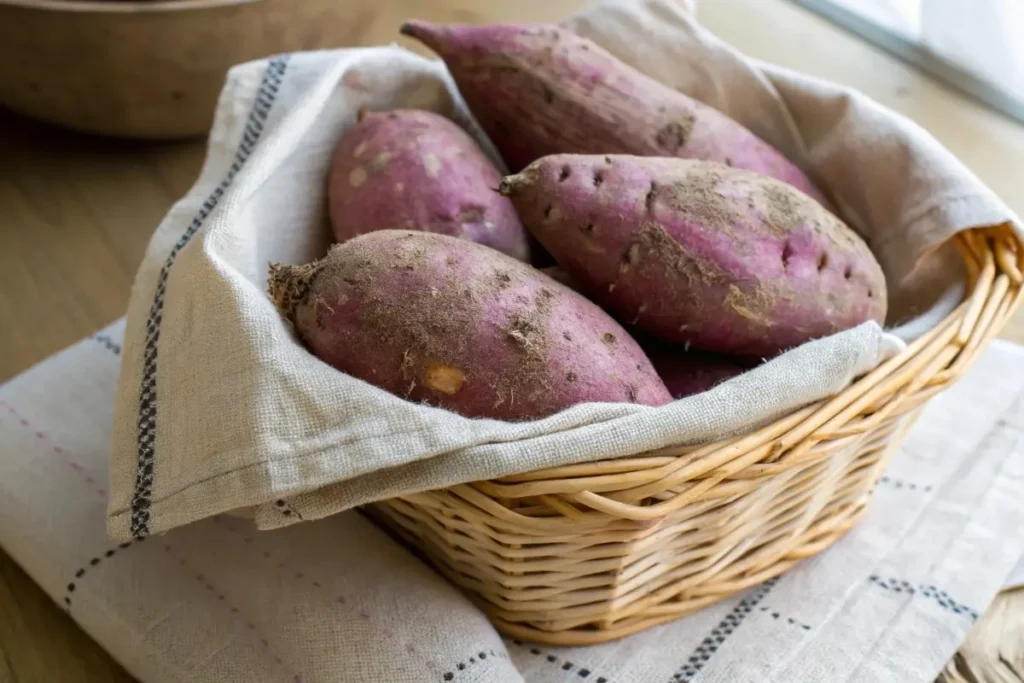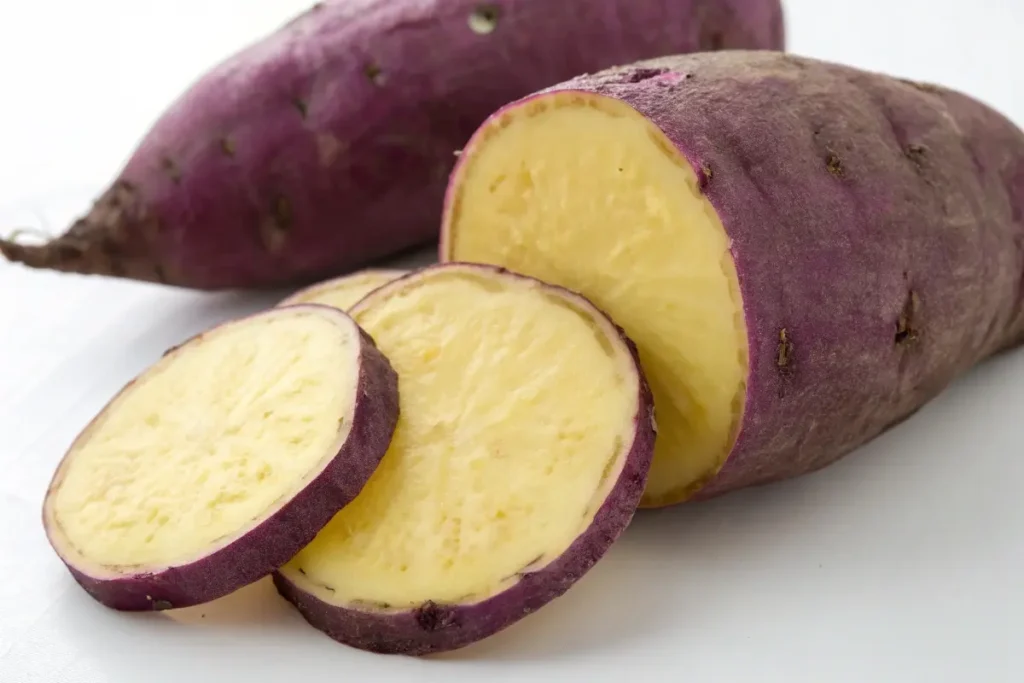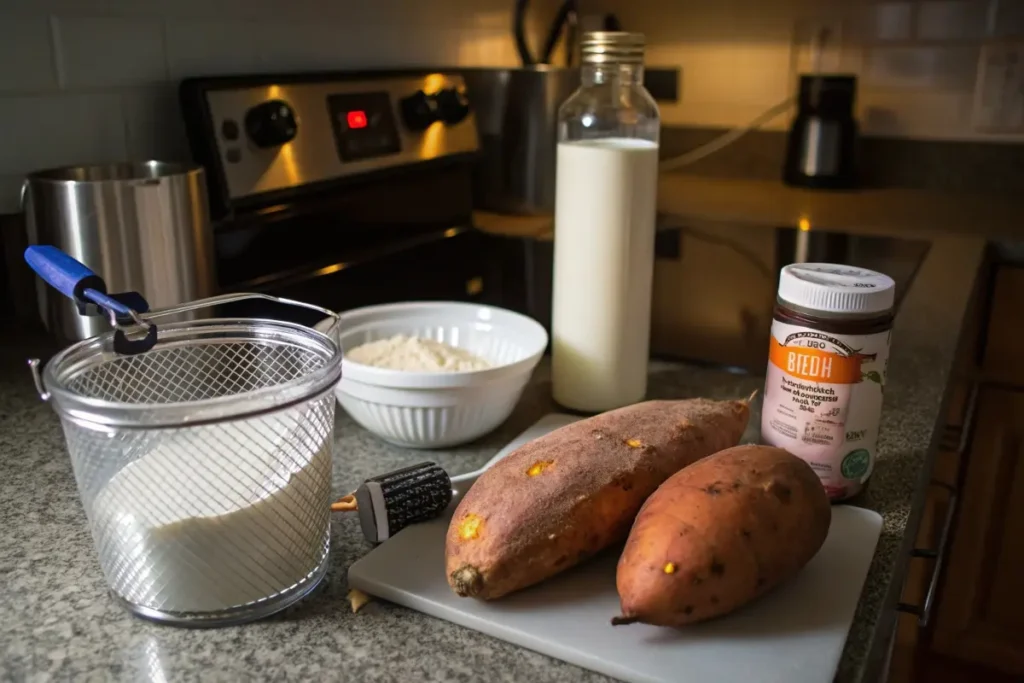Japanese sweet potatoes, often called Satsuma-imo, captivate dessert lovers worldwide with their natural sweetness and smooth, dense texture. Unlike typical orange-fleshed varieties, they boast a purple or reddish skin and pale interior that turns lusciously soft upon cooking. This unique profile makes them an ideal candidate for japanese sweet potato dessert creations—ranging from simple roasted slices topped with butter to more elaborate pastries, puddings, or even creme brulee.
What is a Japanese sweet potato called? Typically, you’ll see names like Satsuma-imo (literally “potato from Satsuma Province”) in grocery stores across Japan, referencing their place of origin and hallmark sweetness. As these tubers gain popularity abroad, international chains sometimes stock them under labels like “Japanese sweet potato,” sparking curiosity about their differences from standard sweet spuds. The answer lies in their flavor, dryness, and firm texture, all of which lend themselves well to confections. For those with a sweet tooth, a Japanese Sweet Potato Dessert is a must-try—its subtle sugary profile, reminiscent of roasted chestnuts, pairs elegantly with cream, dairy, or nut-based ingredients.
Whether you’re looking to replicate a japanese sweet potato cake or whip up a sweet potato paste for confections, these root vegetables promise delight in every bite. If you’re new to this ingredient, consider trying our Mashed Japanese Sweet Potato Recipe for a smooth, comforting side. Now, let’s embark on an in-depth exploration of how these sweet potatoes transform into must-try desserts in Japan and beyond.

Discovering What Makes Japanese Sweet Potatoes Special
1. Distinct Color and Texture
Compared to the commonly found orange-fleshed sweet potatoes, Satsuma-imo typically has a reddish or purple skin and a pale, creamy interior. Upon cooking, the flesh becomes moist yet maintain a velvety firmness—perfect for shaping into confections or used in japanese sweet potato dessert dishes. The flavor is milder than typical Western sweet potatoes, sporting a nutty sweetness akin to roasted chestnuts or mild honey.
- Lower Moisture Content: These tubers have less water, enabling them to hold shape when mashed or pureed. This dryness also intensifies the sugar content for a pronounced sweetness.
- Thin but Flavor-Packed Skin: In many Japanese recipes, the skin is sometimes left on for color contrast and extra nutrients.
2. Nutritional Benefits
Japanese sweet potatoes are packed with fiber, vitamins (particularly vitamin C and B6), and minerals like potassium. Their lower glycemic index than regular white potatoes helps sustain stable energy levels. This nutritional profile fuels not only savory forms—like in japanese sweet potato curry—but also dessert variants, offering a guilt-reduced sweetness.
3. Varieties and Availability
These sweet potatoes flourish in southwestern Japan, especially Kagoshima (formerly Satsuma). With globalization, they’re appearing in more grocery stores internationally, prompting queries like Does Trader Joe’s have Japanese sweet potatoes? Indeed, some specialty grocers and organic markets abroad feature them seasonally. The distinct label “Japanese sweet potato” helps shoppers differentiate them from other types.
4. Popular Dessert Forms
a) Japanese Sweet Potato Creme Brulee
A luscious spin on classic creme brulee. Pureed Satsuma-imo is blended with cream, sugar, and eggs, resulting in a smooth custard topped with a caramelized sugar crust. The mild, earthy note of the sweet potato complements the dessert’s rich sweetness, making it an innovative treat.
b) Japanese Sweet Potato Cake
Moist, dense, and lightly sweet, sweet potato cake can incorporate chunks or pureed sweet potato for a subtle flavor boost. The batter often includes minimal spices, ensuring the tuber’s unique essence shines through.
c) Sweet Potato Paste or Mont Blanc
You’ll find Japanese sweet potato paste in pastries akin to a chestnut Mont Blanc. This thick, sweet spread is piped over cakes or pastries, forming eye-catching swirls reminiscent of the French dessert.
d) Simple Roasted Treat
A staple in Japan, roasted sweet potatoes (“yaki imo”) grace street stalls in autumn and winter. Eaten plain, the comforting sweetness can easily become a base for a variety of desserts, from chilled parfaits to spiced cookies.
5. Cultural Significance
Beyond taste, Satsuma-imo gained prominence post-World War II for its role in feeding a hungry population. People regard it as humble yet essential, bridging old traditions (like childhood memories of sizzling yaki imo trucks) with modern innovations (like sweet potato lattes). This mix of nostalgia and novelty shapes how japanese sweet potato dessert remains beloved—comforting enough for everyday indulgence, yet refined enough for high-end patisseries.
If you’re new to cooking with these tubers, start simple. Explore our Japanese Sweet Potato Air Fryer Recipe for a crisp-on-the-outside, fluffy-on-the-inside snack. Or dip your toes into more advanced desserts—like a luscious sweet potato creme brulee—to experience the tuber’s multi-layered sweetness fully.

Key Ingredients and Techniques in Japanese Sweet Potato Desserts
1. Core Flavor Pairings
In japanese sweet potato dessert recipes, a handful of other staple ingredients complement the tuber:
- Milk or Cream: Whether in puddings or creme brulee, dairy underscores the tuber’s gentle sweetness.
- Sugar Alternatives (like honey or agave): Milder sweeteners retain the potato’s distinctive taste without overshadowing it.
- Butter: Provides richness, commonly used in cakes or pastry fillings.
- Matcha or Red Bean Paste: Occasionally combined for a layered Japanese twist.
2. Traditional vs. Modern Approaches
a) Traditional Techniques:
- Mashing and Sieving: For refined desserts—like sweet potato paste—cooks often mash the boiled or roasted tubers, then pass them through a fine sieve for a silky texture.
- Steaming: A gentle method that preserves nutrients and flavor, preparing sweet potatoes for simpler sweets or mochi fillings.
b) Contemporary Takes:
Chefs and home bakers experiment with fusions—like sweet potato cheesecakes or sweet potato mont blanc, swirling the paste on top of chiffon cakes. Even sweet potato creme brulee merges classical French technique with the subtlety of Satsuma-imo.
3. Equipment Essentials
To craft these desserts, a few tools come in handy:
- Fine Mesh Sieve: Ensures the sweet potato puree is ultra-smooth, essential for delicate textures.
- Kitchen Torch: For that perfect caramelized sugar topping in creme brulee.
- Baking Mats and Molds: Many Japanese sweets are petite or intricately shaped, calling for specialized molds that highlight the tuber’s color.
4. Avoiding Overpowering Spices
In Western sweet potato or pumpkin desserts, warming spices like cinnamon, nutmeg, or cloves are common. Japanese treats, however, generally reduce or omit heavy spicing, letting the Satsuma-imo itself stand front and center. That said, a subtle hint of cinnamon might occasionally appear in bakery items, especially in big city shops that cater to global palates. For a more traditional experience, try a Japanese Sweet Potato Dessert where the natural sweetness of the sweet potato shines without the distraction of overpowering spices.
5. Step-by-Step for a Simple Japanese Sweet Potato Cake
- Prep and Peel: Wash one or two medium Japanese sweet potatoes, peel the skin, and cut into chunks.
- Boil or Steam: Cook until fork-tender, then mash thoroughly. A dash of butter or cream can be added to enhance richness.
- Mix the Batter: Combine eggs, sugar, a bit of flour, and the sweet potato puree. An electric mixer helps achieve a smooth consistency.
- Bake: Pour into a greased pan and bake at moderate heat (~180°C/350°F) until a toothpick emerges clean.
- Serve: Enjoy warm or chilled, possibly topped with whipped cream or a dusting of powdered sugar.
Looking for a savory angle? Our Mashed Japanese Sweet Potato Recipe reveals how the same tubers can become a comforting side dish. The flexible nature of Satsuma-imo means you can pivot between dessert and savory with minimal fuss, relying on Shinto-inspired respect for natural, unmasked flavors.

History and Examples of Japanese Sweet Potato Dessert
Historical Roots of Sweet Potato in Japan
Sweet potatoes initially arrived in Japan via China in the early 17th century, particularly thriving in the southern regions. During the Edo period, they served as a reliable famine-relief crop due to their resilience and yield. Over time, the tuber—known for its natural sweetness—gained traction in confections and everyday snacks. Roasted sweet potatoes sold by street vendors became a cultural fixture, especially in winter, with a nostalgic call of “yaki imo” echoing down city streets.
From Survival Food to Gourmet Dessert
While sweet potatoes once symbolized humble sustenance, increased affluence in modern Japan saw them evolve into premium dessert bases. Pastry chefs recognized the tuber’s dense, sugary interior as an excellent canvas. Ningyo-yaki (doll-shaped sweet potato cakes) or imo yokan (a gelatinous sweet potato block) emerged, bridging comfort food with refined sweet delicacies. Eventually, Western-style patisseries in Japan started experimenting, producing sweet potato soufflés or cheesecakes.
- Sweet Potato Mont Blanc: Borrowed from chestnut Mont Blanc style, this version replaces chestnut puree with sweet potato paste, piping it into swirling towers over sponge cake or tart.
- Sweet Potato Soft Serve: Some shops in Japan offer a seasonal Satsuma-imo flavored soft-serve, tinted a gentle purple, tapping into the “instagrammable” novelty.
Revival of Retro Sweets
Amid shifting tastes, traditional sweets—like daigaku imo (glazed sweet potato chunks) or imo yokan—still hold their own. These confections reflect an older Japan, where sugar was precious and flavors simpler. Even today, these items remain staples in festivals or gift shops, celebrating the tuber’s unadulterated taste.
Popular Contemporary Creations
- Japanese Sweet Potato Creme Brulee: A modern reinterpretation mixing French technique and local produce. Creamy custard meets caramelized top in a perfect East-meets-West dessert.
- Sweet Potato Paste-Filled Breads: Bakeries fill soft buns with lightly sweetened Satsuma-imo paste for a portable treat.
- Cakes and Swiss Rolls: Jiggly, airy cake sponges swirl with sweet potato buttercream or jam, a visual delight that also pleases the palate.
For those exploring how Japanese sweet potato desserts fit into overall dessert culture, you might enjoy our Japanese Dessert Recipes. Notice how the inclusion of sweet potato parallels longstanding traditions of highlighting local crops, from matcha to azuki beans. Indeed, each sweet potato creation merges heritage with a touch of global dessert influence, encapsulating the evolution of a once-humble root into a sophisticated sweet star.
Practical Examples/Use Cases
Wondering how a japanese sweet potato dessert might fit into your cooking repertoire? Here are some everyday scenarios and creative ideas:
1. Family Dessert Night
- Scenario: A family looking for a healthier treat than sugary pastries.
- Approach: They boil or roast Satsuma-imo, mash it into a soft puree with milk and a hint of sugar, shaping it into small patties and baking until slightly golden.
- Result: Lightly sweet discs, akin to cookies but with fewer processed ingredients. Kids love the gentle sweetness, and parents appreciate the vitamins and fiber.
2. Fusion Bakery Start-Up
- Scenario: An aspiring baker wants a unique product line.
- Approach: She concocts sweet potato Swiss rolls with buttercream tinted purple using the tuber’s natural hue, or tries a japanese sweet potato creme brulee cupcake.
- Benefit: The novelty of colorful sponges and local-inspired fillings draws in curious customers, bridging familiar Western pastries and exotic Japanese elements.
3. Holiday Gatherings
- Scenario: Thanksgiving or potluck gatherings.
- Approach: Instead of a standard pumpkin pie, one might prepare a sweet potato pie or cheesecake featuring Satsuma-imo for an unexpected twist.
- Advantage: Guests discover a softer, chestnut-like flavor that sets it apart from typical orange yams.
4. Gift-Giving Tradition
- Scenario: In Japan, it’s common to bring gifts when visiting someone’s home.
- Approach: A box of sweet potato “manju” or imo yokan can be an elegant, less mainstream treat.
- Impact: Showcases refined taste, plus introduces recipients to the comforting sweetness that sets Japanese sweet potatoes apart.
For more ideas on how to incorporate these tubers into everyday cooking, see our Japanese Chicken Fried Rice Recipe—maybe adding small, pre-roasted sweet potato chunks for a subtle sweet-savory flair. Ultimately, japanese sweet potato dessert possibilities abound, from casual home baking to artisanal patisserie concepts, proving these tubers’ remarkable adaptability.

FAQs about Japanese Sweet Potato Dessert
1. What is so special about Japanese sweet potatoes?
They boast a unique, often purple or reddish skin and pale interior that’s naturally sweet and dense. Their flavor leans towards chestnut-like sweetness, making them ideal for japanese sweet potato dessert recipes, from cakes to creme brulee. They’re also higher in certain nutrients compared to standard orange varieties.
2. What is the best way to eat Japanese sweet potatoes?
Many find that simply roasting them preserves their inherent sweetness—yielding a caramelized exterior and moist interior. They can also be steamed, boiled, or used in sweets like pie fillings, pastries, and sweet potato paste. The dryness amplifies the sweet essence, ensuring versatility in a range of dishes.
3. What is a Japanese sweet potato called?
Typically called Satsuma-imo, referencing their region of origin (Satsuma in Kagoshima). However, you might also see variations named “Beniazuma” or “Anno imo,” each with specific flavor notes. In English-speaking markets, they’re labeled “Japanese sweet potato” to differentiate them from orange-fleshed sorts.
4. Does Trader Joe’s have Japanese sweet potatoes?
Depending on the region and season, some Trader Joe’s or specialty grocery chains carry Japanese sweet potatoes. Availability can be sporadic—particularly in fall or winter—when these tubers are at peak demand. If you don’t spot them at your local store, you might try an Asian market or farmer’s market.
5. Are they healthier than regular sweet potatoes?
Nutritionally, they’re fairly comparable, rich in fiber, vitamins, and minerals. The difference lies in taste and texture rather than a drastic nutritional gap. Both forms are considered healthier carbohydrate sources with moderate glycemic impact.
6. Any popular dessert variations?
Yes, from japanese sweet potato creme brulee to sweet potato cake to a simple roasted treat drizzled with honey. In local patisseries, you might find Mont Blanc-style confections piped with sweet potato paste. Creative bakers fuse them into cheesecakes or custards, celebrating their mild, comforting flavor.
7. Where can I learn more about traditional uses?
Visiting local farmers’ markets in Japan, especially during autumn, reveals how widely they’re enjoyed—roasted yaki imo stands are iconic. You can also browse our Traditional Japanese Desserts Recipe to see how sweet potatoes often appear alongside other staple flavors like matcha or azuki beans.

Conclusion
In essence, japanese sweet potato dessert highlights the soft sweetness and creamy texture of Satsuma-imo. Whether you savor a simple roasted wedge, craft a decadent japanese sweet potato creme brulee, or explore the world of sweet potato cakes and pastries, these tubers deliver an unmistakable note of comforting, mildly sweet flavor. Their nutritional advantages and adaptability in both traditional and modern recipes underscore why they’ve become a staple for dessert enthusiasts.
If you’re intrigued, consider starting with something simple—like roasting or steaming your first batch. For those seeking more elaborate creations, go for a creme brulee, layered sweet potato tart, or a Mont Blanc-inspired Japanese Sweet Potato Dessert using sweet potato paste. With basic tools (like a mesh sieve and perhaps a kitchen torch), you can replicate patisserie-worthy treats in the comfort of home.
Ready to bring more sweet potato magic into your cooking? Check out our Japanese Pumpkin Recipe for a similarly sweet yet distinct cousin to sweet potatoes, further proving how Japan’s humble root vegetables can produce extraordinary desserts. Ultimately, Satsuma-imo’s unique taste, easy preparation, and healthful profile ensure it remains a beloved ingredient for both beginners and culinary pros—delivering sweet moments in every bite.

